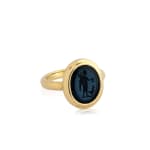

Roman
Mercury nicolo gold ring, Roman, circa 1st - 3rd century AD
Nicolo
Ring size UK: N 1/2
Length of intaglio: 1.3 cm
Length of intaglio: 1.3 cm
The ancient Roman oval gem in two layers of colour: pale blue on dark blue/black. The gem is engraved with the standing figure of the god Mercury/Hermes, depicted nude, with...
The ancient Roman oval gem in two layers of colour: pale blue on dark blue/black. The gem is engraved with the standing figure of the god Mercury/Hermes, depicted nude, with a cloak at his right arm with which he holds his caduceus, a purse in his left hand, a cockerel at his feet.
Provenance
Gustave Mustaki Collection, Alexandria, acquired in the early part of the 20th century and exported to England before 1953Gustave Mustaki moved from Greece to Alexandria, Egypt, when he was a boy. A fanatic collector from a young age, over his lifetime he amassed a huge collection. Towards the end of the 1940s he applied to the Egyptian government to export his collection. Although the government kept some items of importance, they granted permission for several crates of statuettes and amulets to be shipped to London. The full contents were recorded by by the shippers, on 15th May 1953. Though the process had begun several years earlier, by late 1953 Harrods had received delivery of the cases and the objects were sent to Mustaki's daughter Elsa MacLellan and have been slowly dispersed since

